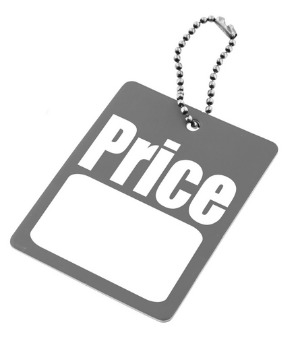 Since launching Real Estate Blog Topics, I’ve learned that properly pricing a product can be tricky.
Since launching Real Estate Blog Topics, I’ve learned that properly pricing a product can be tricky.
A low price says, “I lack confidence in my product and I’ll take what I can get.” While a high price says, “I’m confident about the value of my product and the premium price is worth it.” But set the price too high, and you’ll price yourself out of the market.
So where’s that happy medium?
Here’s a couple of things to consider when setting a price:
1. Don’t be afraid to charge what you’re worth.
If you think you’re product/service is worth $97, then charge just that. But do so with confidence. Sure, some people will complain about the price. There’s always going to be someone who thinks it’s priced to0 high. But then, there will be others who see the value in what you have to offer and they’ll be happy to pay the requested price.
The key of course is to effectively communicate the value proposition in your offering. Remember, price is what you pay. Value is what you get. (Tweet this)
Personal Experience:
When I first launched Real Estate Blog Topics, I set an introductory price of $3.99 for the first 20 subscribers, then moved it up to $9.99. The current price is now $25 per month. What I found is that it was just as difficult, if not more difficult, to get people to op-in at the lower price-point than the current price. I think this had to do with the perception of value (or lack of) that the lower price ingrained in people’s mind.
2. Study the market for competing products and determine your point of differentiation.
Are there other companies out there that have a service offering similar to yours? Find them, then ask yourself a couple of things:
- What do they have to offer that you don’t?
- What’s their process like? From purchase, to downloading/accessing the content, to customer service?
- What can you do better?
- What do they charge? And does your value proposition justify being able to charge/command a higher price?
3. Don’t offer discounts too often.
If you offer a discount long enough, it no longer becomes a discount. It becomes expected. Take the local restaurant that offers a weekly special for 20% off. The retail store that offers a weekly special, or the car dealership that has a “sale” sign on display every day of the week.
A discount isn’t really a surprise anymore, it’s expected.
Companies like StudioPress on the other hand, offer a premium product that people are willing to pay for. At full price. They run a discount once per year (their annual Black Friday sale). But other than that, discounting isn’t in their business model.
Personal Experience:
I’ve discounted the registration price on Real Estate Blog Topics once (on Black Friday) since increasing the price to $25/month. I’ve had people ask if I’d be offering a discount any time soon to which I’ve replied, “No, sorry.” A few of those same people who asked about discounting the price, were happy to sign-up at full price regardless.
Really, it’s all about communicating your value appropriately. If people see the value, they’re going to register.
4. Inject value into every step of the process.
You can’t charge more for a crap product/service. So you need to inject value into everything that you do. From the moment a customer signs up, to every single interaction they have with your service thereafter.
Think customer service doesn’t scale? Or that it’s not a point of differentiation? Think again… This is an art that Zappos mastered throughout their customer service department. With each interaction they had, they did their very best to correct issues and make every interaction they had with a customer, a pleasant experience. They eventually sold for close to a billion dollars.
Price Is What You Pay. Value Is What You Get.
The way I see it, people are willing to pay a premium when they see the value in what you have to offer. So it’s up to you to communicate that value up-front effectively. But it doesn’t end there, you have to deliver on your product/service through and through from that point forward.
Do that well, and you have a product that scales.
What do you think? How do you go about determining the price for a product/service?

Leave a Reply